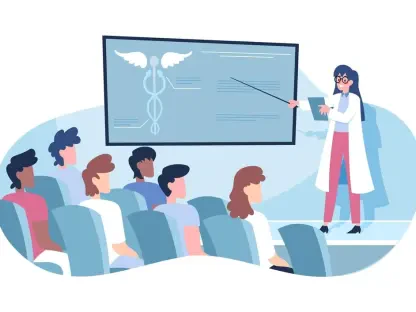Healthcare interoperability is a critical issue in the modern medical landscape, requiring a delicate balance between innovation, patient data access, and security. Over the past decade, significant strides have been made, primarily due to the widespread adoption of electronic health records (EHR). However, numerous challenges remain, necessitating the exploration of advanced technologies to overcome these hurdles.
The Evolution of Healthcare Interoperability
The Shift from Paper to Digital Records
The transition from paper to digital records has revolutionized data management in healthcare and electronic health records (EHR) have enabled more efficient sharing of critical health information among providers, significantly improving patient care. Major EHR vendors like Cerner and Epic have led efforts to implement standardized protocols for data sharing, which are essential for enhancing patient experiences and ensuring continuity of care. This shift has fundamentally transformed how healthcare providers access and utilize patient information, allowing for better coordination and comprehensive care strategies across different healthcare settings.
The adoption of EHRs has not only streamlined administrative processes but has also reduced errors associated with manual record-keeping. By creating a unified digital platform, healthcare providers can now easily access a patient’s complete medical history, resulting in more accurate diagnoses and tailored treatment plans. However, while the benefits of EHRs are undeniable, the journey towards seamless interoperability is far from complete. The need for harmonized data standards and the integration of diverse healthcare systems remain significant challenges that must be addressed to fully realize the potential of digital health records.
The Role of TEFCA and QHINs
The Trusted Exchange Framework and Common Agreement (TEFCA) has been instrumental in establishing a nationwide framework for interoperability, and central to this framework are Qualified Health Information Networks (QHINs). QHINs act as hubs for secure data exchange among various healthcare entities, facilitating better clinical decision-making and addressing issues related to data silos and fragmented health systems. By providing a standardized approach to data sharing, TEFCA aims to create a more cohesive and integrated healthcare environment that promotes seamless information flow and enhances patient outcomes.
These networks empower healthcare providers with the ability to access critical patient information from different sources, irrespective of geographical boundaries. This level of connectedness is crucial for improving emergency care, coordinated treatments, and preventive measures, ultimately leading to a more responsive and efficient healthcare system. However, the implementation of TEFCA and the integration of QHINs come with their own set of challenges, including aligning diverse healthcare organizations with varying levels of technical maturity and encouraging widespread adoption and compliance with new standards.
Challenges in Achieving Seamless Interoperability
Inconsistencies in Data Sharing
Despite the progress made, inconsistencies in data sharing persist even among organizations using the same EHR system, arising from differing data standards and varying levels of user proficiency. TEFCA and the Office of the National Coordinator for Health Information Technology (ONC) are working to develop universal standards like Fast Healthcare Interoperability Resources (FHIR) to address these discrepancies. However, the implementation of FHIR varies among systems, creating further challenges that necessitate continued efforts towards uniformity and consistency in data exchange practices.
These inconsistencies can lead to fragmented information and compromised patient care, as healthcare providers may not have access to complete and accurate patient data when making critical decisions. The lack of standardized data formats and the diverse landscape of EHR systems contribute to these challenges, underscoring the need for interoperable solutions that can bridge the gaps between different platforms. Efforts to harmonize data exchange protocols must be accompanied by comprehensive training programs to ensure that healthcare professionals are proficient in utilizing these systems effectively.
The Absence of a Unique Patient Identifier
One of the most significant obstacles to seamless interoperability is the lack of a unique patient identifier, which results in cumbersome processes and delays in patient care due to disputes over data requests between healthcare organizations. The absence of such an identifier complicates efforts to match patients accurately with their medical records, leading to potential errors and inefficiencies. There is a growing consensus on the need for more robust patient involvement in data management, envisioning a system where patients could authorize data sharing through a single, comprehensive permission mechanism.
Implementing a unique patient identifier could streamline the data sharing process, reducing administrative burdens and enhancing the quality of care by ensuring that healthcare providers have access to complete and accurate patient information. However, the development and deployment of such an identifier raise concerns related to privacy and security. It is essential to strike a balance between improving interoperability and safeguarding sensitive patient data to prevent unauthorized access and potential misuse.
Balancing Patient Control and Data Security
Empowering Patients with Data Management
Balancing patient control over data with the privacy and security of sensitive information is crucial in advancing healthcare interoperability. Empowering patients to authorize broader sharing of their medical information, including granting blanket permissions for data to be shared with any healthcare provider, hospital, or insurance company involved in their care, is suggested. This approach would minimize repeated consent requests and expedite access to care. Patients could manage their preferences similarly to internet cookie settings, adjusting their data sharing permissions as needed to reflect their changing healthcare needs and preferences.
Such a system would not only enhance patient autonomy but also improve the efficiency of healthcare delivery by ensuring that providers have timely access to relevant information. However, implementing this level of patient control requires robust and user-friendly platforms that facilitate seamless data management. Additionally, there must be comprehensive education and support for patients to help them understand their rights and options regarding data sharing, ensuring that they are adequately informed when making decisions about their health information.
Ensuring Robust Privacy and Security Measures
While empowering patients, it is essential to maintain stringent privacy and security measures to protect sensitive data, including the ability for patients to revoke consent at any time in line with HIPAA regulations. A regulated system would ensure that patient information is used only as authorized and secure from unauthorized access. This requires implementing advanced security protocols and continuous monitoring to detect and prevent potential breaches. In addition, healthcare organizations must establish clear guidelines and processes for managing patient consent and data access, ensuring transparency and accountability in handling sensitive information.
Maintaining a balance between enhancing data accessibility and safeguarding privacy is a complex challenge that requires ongoing collaboration among healthcare providers, technology developers, and regulatory bodies. As the healthcare industry continues to embrace digital transformation, it is crucial to prioritize data security and patient privacy in all interoperability initiatives. This commitment will help build trust among patients and healthcare providers, fostering a more collaborative and effective healthcare ecosystem.
The Role of Advanced Technologies
Artificial Intelligence and Machine Learning
Technological advancements such as artificial intelligence (AI) and machine learning (ML) are at the forefront of improving interoperability. AI and ML enable the standardization and tagging of data, making it easier for healthcare providers to search, retrieve, and utilize information swiftly. Unlike traditional cumbersome PDFs, discrete data sets allow quick access to specific details, enhancing efficiency and care quality. By leveraging AI and ML, healthcare organizations can transform unstructured data into structured, actionable insights, facilitating better decision-making and patient outcomes.
AI and ML can also assist in identifying patterns and
trends within large datasets, providing valuable insights into patient health and enabling more personalized treatment plans. These technologies can automate routine tasks, such as data entry and coding, reducing the administrative burden on healthcare professionals and allowing them to focus on patient care. However, the successful integration of AI and ML in healthcare interoperability requires robust infrastructure, continuous learning, and adaptation to ensure accurate and reliable outcomes.
Natural Language Processing and Data Management
Natural language processing (NLP) is another critical technology in resolving interoperability challenges, helping to deconstruct large documents into manageable discrete elements and reduce risks associated with data mismanagement. NLP allows healthcare providers to extract meaningful information from unstructured text, such as clinical notes and medical records, and convert it into structured data that can be easily accessed and analyzed. This technology is particularly useful in dealing with legacy systems that store entire patient records in single PDFs, making data extraction and analysis more efficient and error-free.
NLP can also enhance the interoperability of healthcare systems by enabling more accurate and consistent data entry, reducing the variability and ambiguity often associated with manual documentation. By automating the extraction and standardization of data, NLP helps create a more cohesive and integrated healthcare ecosystem. This, in turn, enables healthcare providers to deliver more precise and timely care, ultimately improving patient outcomes.
The Future of Healthcare Interoperability
Enforcing Stricter Standards
Looking ahead, it is important for regulatory bodies like the ONC to enforce stricter standards for data storage and accessibility. Ensuring that data stored discretely is not only accessible but also usable is key to maximizing the benefits of technological advancements. Standardized data formats and protocols are essential for achieving true interoperability, allowing healthcare providers to share and access information seamlessly across different systems and platforms. Enforcing stricter standards will help reduce variability and ensure that all healthcare entities adhere to the same guidelines, promoting a more uniform and efficient data exchange process.
Stricter standards also play a crucial role in enhancing data security and privacy, ensuring that sensitive patient information is protected from unauthorized access and potential breaches. As the healthcare industry continues to evolve, it is essential to continuously update and refine these standards to keep pace with emerging technologies and threats. By fostering a culture of compliance and accountability, regulatory bodies can help create a more secure and reliable healthcare environment.
Collaboration Among Stakeholders
Healthcare interoperability is a crucial issue in today’s medical field, requiring an expert blend of innovation, patient data access, and security measures. Over the last ten years, we’ve seen significant progress, mainly due to the widespread integration of electronic health records (EHR). These digital records have revolutionized how information is shared and accessed across various healthcare providers. However, the road to full interoperability is still fraught with many challenges like differing systems, data formats, and privacy concerns, which complicate data sharing and patient care.
The adoption of EHRs has undoubtedly paved the way for advancements in this area, but it’s clear that more sophisticated technologies need to be explored and implemented to overcome existing obstacles. Blockchain, artificial intelligence, and advanced machine learning algorithms are among the technologies that hold promise for addressing these issues. Effective interoperability would allow healthcare providers to offer more personalized and efficient care, improve outcomes, and enhance overall patient satisfaction by ensuring that critical information is readily available when needed, while maintaining robust security protocols.









